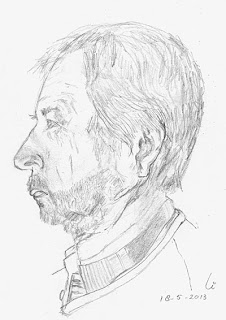Ann and Ellie have had problems of one kind or another with their homework this session but they have produced some very good likenesses from photographs. From life has proven a greater challenge and I have reiterated my comments below mainly since it is good to know what went well and what needs further practise.
 Ann and Ellie have come a long way since their first lesson and they know that to improve their life drawing they simply need to keep looking and looking and looking and keep practising. It can take years to be able to produce a reasonable likeness. It doesn't come easily but I do hope they continue to work at their life studies.
Ann and Ellie have come a long way since their first lesson and they know that to improve their life drawing they simply need to keep looking and looking and looking and keep practising. It can take years to be able to produce a reasonable likeness. It doesn't come easily but I do hope they continue to work at their life studies. These full face portraits are from life.
These full face portraits are from life.Two very common early observation errors here..eyes too close to the centre of the face and distance from end of nose to chin too short.
These observational errors don't occur so much when drawing full face from photos, because the subject is already 2D isn't so intimidating. Although Ann's shading was somewhat over-zealous.
This self portrait profile (left) was done from a photo and although the head is too narrow the facial profile is actually very well observed and the features are proportionate.
The live profile on the right still gave Ann trouble with the chin proportions and the position of the eye, which doesn't 'sit' in the face. But still some very good and strong line and it is obviously a 'real person.'
Her two profile studies from photos were very well observed and were proportionally sound
Ellie's full face live portrait shows another common difficulty and that again is the placement of the eyes. Here they are slightly too far apart and high in the face rather than being close to the halfway point of the face.
Again when drawing from photos the proportions and images become closer to the subject but even here you can see that the eyes are still slightly to wide apart.
Profile drawing was slightly easier although the skull proportion in this life study again was squashed slightly.
Elly's photo profiles here show that she can see the normally wide back of the skull when the image is 2D. These two studies were really well done.
Three-quarter portraits from photos throw up extra challenges and I was glad to see that Ellie managed to get the tilt of the head and proportions of the subject although the right eye was not angled enough be able to sit on the tilt line of the eyes. Still, well observed and nicely drawn.
So congratulations to both Ann and Ellie for producing studies that mainly are lifelike and well observed.
Next time it's the dreaded...PROPORTION!




















































